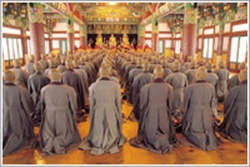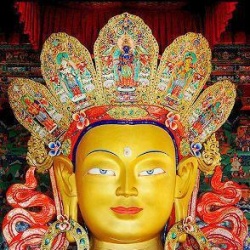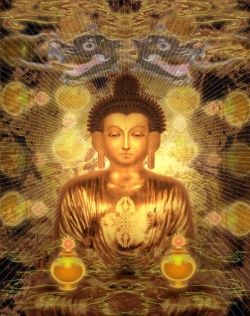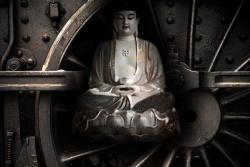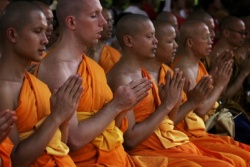Difference between revisions of "Rong-zom Chos-kyi-bzang-po"
m (Text replacement - "]]]" to "]])") |
|||
| (2 intermediate revisions by one other user not shown) | |||
| Line 1: | Line 1: | ||
| − | + | <nomobile>{{DisplayImages|2142|2648|4513|4152|2298}}</nomobile> | |
| + | |||
| + | |||
| Line 5: | Line 7: | ||
[[Rongzom Chokyi Zangpo]] | [[Rongzom Chokyi Zangpo]] | ||
| − | [[Rongzom Chökyi Zangpo]] ([[Tibetan]]: {{BigTibetan|[[རོང་ཟོམ་ཆོས་ཀྱི་བཟང་པོ]]}}, [[Wylie]]: [[rong zom chos kyi bzang po]]) (1012–1088), widely known as [[Rongzom Mahapandita]], [[Rongzom Dharmabhadra]], or simply as [[Rongzompa]], was one of the most important [[scholars]] of the [[Nyingma school]] of [[Tibetan Buddhism]]. Together with [[Longchenpa]] and [[Ju Mipham]], he is often considered to be one of the three "[[omniscient]]" writers of the school. His elder contemporary [[Atiśa]] (980–1054) considered [[Rongzompa]] to be an [[incarnation]] of the [[Indian]] [[ācārya]] [[Kṛṣṇapāda]], the Great. The [[Tibetan]] historian [[Gö Lotsawa]] (1392–1481) said of [[Rongzom]] that no [[scholar]] in [[Tibet]] was his {{Wiki|equal}}. | + | [[Rongzom Chökyi Zangpo]] ([[Tibetan]]: {{BigTibetan|[[རོང་ཟོམ་ཆོས་ཀྱི་བཟང་པོ]]}}, [[Wylie]]: [[rong zom chos kyi bzang po]]) (1012–1088), widely known as [[Rongzom Mahapandita]], [[Rongzom Dharmabhadra]], or simply as [[Rongzompa]], was one of the most important [[scholars]] of the [[Nyingma school]] of [[Tibetan Buddhism]]. |
| + | |||
| + | Together with [[Longchenpa]] and [[Ju Mipham]], he is often considered to be one of the three "[[omniscient]]" writers of the school. | ||
| + | |||
| + | His elder contemporary [[Atiśa]] (980–1054) considered [[Rongzompa]] to be an [[incarnation]] of the [[Indian]] [[ācārya]] [[Kṛṣṇapāda]], the Great. | ||
| + | |||
| + | The [[Tibetan]] historian [[Gö Lotsawa]] (1392–1481) said of [[Rongzom]] that no [[scholar]] in [[Tibet]] was his {{Wiki|equal}}. | ||
| + | |||
A.W. Barber writes that [[Rongzom]] was the first to receive the entire [[Dzogchen teachings]] of both [[Vimalamitra]] and [[Vairocana]] after the time of those two [[masters]]. According to the [[Blue Annals]], [[Rongzom Chokyi Zangpo]] ... received the [[Semde]] ([[sems sde]]) teachings of the [[Dorje Dudjom]] [[transmission]] line. | A.W. Barber writes that [[Rongzom]] was the first to receive the entire [[Dzogchen teachings]] of both [[Vimalamitra]] and [[Vairocana]] after the time of those two [[masters]]. According to the [[Blue Annals]], [[Rongzom Chokyi Zangpo]] ... received the [[Semde]] ([[sems sde]]) teachings of the [[Dorje Dudjom]] [[transmission]] line. | ||
| Line 16: | Line 25: | ||
By now we have seen that [[Rongzom]] regards the [[views]] of the [[Sutrayana]] as {{Wiki|inferior}} to those of [[Mantra]], and he underscores his commitment to the [[purity]] of all [[phenomena]] by criticizing the [[Madhyamaka]] [[objectification]] of the [[Wikipedia:Authenticity|authentic]] [[relative truth]]. | By now we have seen that [[Rongzom]] regards the [[views]] of the [[Sutrayana]] as {{Wiki|inferior}} to those of [[Mantra]], and he underscores his commitment to the [[purity]] of all [[phenomena]] by criticizing the [[Madhyamaka]] [[objectification]] of the [[Wikipedia:Authenticity|authentic]] [[relative truth]]. | ||
| + | |||
Writings | Writings | ||
| − | According to a catalog of the commentaries he codified, the collected works of [[Rongzompa]] amounted to over 100 volumes, the majority of which are no longer extant. In the 19th century, [[Ju Mipham]], who was particularly influenced by Rongzompa's writings, attempted to [[gather]] the surviving works together. | + | |
| + | According to a catalog of the commentaries he codified, the collected works of [[Rongzompa]] amounted to over 100 volumes, the majority of which are no longer extant. In the 19th century, [[Ju Mipham]], who was particularly influenced by [[Rongzompa's]] writings, attempted to [[gather]] the surviving works together. | ||
Important surviving works of [[Rongzom Chokyi Zangpo]] include: | Important surviving works of [[Rongzom Chokyi Zangpo]] include: | ||
Entering the Way of the [[Great Vehicle]] ([[Mahayana]]) ([[Tibetan]]: {{BigTibetan|[[ཐེག་པ་ཆེན་པོའི་ཚུལ་ལ་འཇུག་པ]]}}, [[Wylie]]: [[theg pa chen po’i tshul la ’jug pa]]) – presents a defense and explanation of the [[Dzogchen tradition]] in the context of the [[Mahayana]]. | Entering the Way of the [[Great Vehicle]] ([[Mahayana]]) ([[Tibetan]]: {{BigTibetan|[[ཐེག་པ་ཆེན་པོའི་ཚུལ་ལ་འཇུག་པ]]}}, [[Wylie]]: [[theg pa chen po’i tshul la ’jug pa]]) – presents a defense and explanation of the [[Dzogchen tradition]] in the context of the [[Mahayana]]. | ||
| + | |||
A commentary on [[Padmasambhava's]] Key Instructions: [[A Rosary of Views]] ([[Tibetan]]: {{BigTibetan|[[མན་ངག་ལྟ་ཕྲེང་གི་འགྲེལ་པ]]}}, [[Wylie]]: [[man ngag lta phreng gi 'grel pa]]) – presents the view of the [[Nyingma]] school's [[nine yanas]]. | A commentary on [[Padmasambhava's]] Key Instructions: [[A Rosary of Views]] ([[Tibetan]]: {{BigTibetan|[[མན་ངག་ལྟ་ཕྲེང་གི་འགྲེལ་པ]]}}, [[Wylie]]: [[man ngag lta phreng gi 'grel pa]]) – presents the view of the [[Nyingma]] school's [[nine yanas]]. | ||
| + | |||
A commentary on the [[Manjusrinama-Samgiti]] ([[Tibetan]]: {{BigTibetan|[[མཚན་ཡང་དག་པར་བརྗོད་པའི་འགྲེལ་པ་རྣམ་གསུམ་བཤད་པ]]}}, [[Wylie]]: [[mtshan yang dag par brjod pa'i 'grel pa rnam gsum bshad pa]]). This has been translated into English in The [[Wisdom]] of [[Manjushri]] (Sherdor, 2012). | A commentary on the [[Manjusrinama-Samgiti]] ([[Tibetan]]: {{BigTibetan|[[མཚན་ཡང་དག་པར་བརྗོད་པའི་འགྲེལ་པ་རྣམ་གསུམ་བཤད་པ]]}}, [[Wylie]]: [[mtshan yang dag par brjod pa'i 'grel pa rnam gsum bshad pa]]). This has been translated into English in The [[Wisdom]] of [[Manjushri]] (Sherdor, 2012). | ||
| + | |||
A commentary on the [[Guhyagarbha Tantra]] ([[Tibetan]]: {{BigTibetan|[[རྒྱུད་རྒྱལ་གསང་བ་སྙིང་པོ་དཀོན་ཅོག་འགྲེལ]]}}, [[Wylie]]: [[rgyud rgyal gsang ba snying po dkon cog 'grel]]) | A commentary on the [[Guhyagarbha Tantra]] ([[Tibetan]]: {{BigTibetan|[[རྒྱུད་རྒྱལ་གསང་བ་སྙིང་པོ་དཀོན་ཅོག་འགྲེལ]]}}, [[Wylie]]: [[rgyud rgyal gsang ba snying po dkon cog 'grel]]) | ||
| + | |||
Establishing the [[Divinity]] of [[Appearances]] ([[Tibetan]]: {{BigTibetan|[[སྣང་བ་ལྷར་བསྒྲུབ]]}}, [[Wylie]]: [[snang ba lhar bsgrub]]) – a short text that presents the [[logical]] grounds for the [[pure]] view of [[Buddhist tantra]]. This text has been translated into English (Köppl, [[Establishing Appearances as Divine]], 2008). | Establishing the [[Divinity]] of [[Appearances]] ([[Tibetan]]: {{BigTibetan|[[སྣང་བ་ལྷར་བསྒྲུབ]]}}, [[Wylie]]: [[snang ba lhar bsgrub]]) – a short text that presents the [[logical]] grounds for the [[pure]] view of [[Buddhist tantra]]. This text has been translated into English (Köppl, [[Establishing Appearances as Divine]], 2008). | ||
| − | The Great Stage of | + | |
| + | The [[Great Stage of Buddhahood]] ([[Sangs rgyas kyi sa chen mo]], Skt. [[Mahābuddhabhūmi]]), translated in [[Rong-zom-pa's]] [[discourses]] on [[buddhology]]: a study of various conceptions of [[buddhahood]] in [[Indian]] sources with special reference to the [[controversy]] surrounding the [[existence]] of [[gnosis]] ([[jñā-na]] : [[ye shes]]) as presented by the eleventh-century [[Tibetan]] [[scholar]] [[Rong-zom Chos-kyi-bzang-po]]), by [[Orni Almogi]] as Volume 24 of Studia philologica Buddhica: Monograph series, The International Institute for [[Buddhist Studies]] of the International {{Wiki|College}} for Postgraduate [[Buddhist Studies]], 2009 | ||
Notes & references | Notes & references | ||
[[Roerich]] (1949) p.160 | [[Roerich]] (1949) p.160 | ||
| + | |||
{{BigTibetan|གཞན་ཕན་ཆོས་ཀྱི་ནང་བ}} p.25 | {{BigTibetan|གཞན་ཕན་ཆོས་ཀྱི་ནང་བ}} p.25 | ||
| + | |||
Barber, 1990 p.301 | Barber, 1990 p.301 | ||
| + | |||
Mandelbaum, Arthur (2007-08). "[[Nanam Dorje Dudjom]]". The [[Treasury of Lives]]: {{Wiki|Biographies}} of [[Himalayan]] [[Religious]] [[Masters]]. Retrieved 2013-08-10. Check date values in: |date= (help) | Mandelbaum, Arthur (2007-08). "[[Nanam Dorje Dudjom]]". The [[Treasury of Lives]]: {{Wiki|Biographies}} of [[Himalayan]] [[Religious]] [[Masters]]. Retrieved 2013-08-10. Check date values in: |date= (help) | ||
| + | |||
[[Germano]] (2002) | [[Germano]] (2002) | ||
| + | |||
Koppl, Heidi. [[Establishing Appearances as Divine]]. [[Snow Lion Publications]] 2008, [[chapter]] 4. | Koppl, Heidi. [[Establishing Appearances as Divine]]. [[Snow Lion Publications]] 2008, [[chapter]] 4. | ||
| Line 62: | Line 83: | ||
<poem> | <poem> | ||
{{W}} | {{W}} | ||
| − | [[Category:]] | + | [[Category:Mahasiddha Kṛṣṇapāda, the Great & Rongzompa]] |
| + | [[Category:Nyingmapa Buddhist teachers]] | ||
Latest revision as of 00:26, 5 April 2016
<poem>
Rongzom Chokyi Zangpo
Rongzom Chökyi Zangpo (Tibetan: རོང་ཟོམ་ཆོས་ཀྱི་བཟང་པོ, Wylie: rong zom chos kyi bzang po) (1012–1088), widely known as Rongzom Mahapandita, Rongzom Dharmabhadra, or simply as Rongzompa, was one of the most important scholars of the Nyingma school of Tibetan Buddhism.
Together with Longchenpa and Ju Mipham, he is often considered to be one of the three "omniscient" writers of the school.
His elder contemporary Atiśa (980–1054) considered Rongzompa to be an incarnation of the Indian ācārya Kṛṣṇapāda, the Great.
The Tibetan historian Gö Lotsawa (1392–1481) said of Rongzom that no scholar in Tibet was his equal.
A.W. Barber writes that Rongzom was the first to receive the entire Dzogchen teachings of both Vimalamitra and Vairocana after the time of those two masters. According to the Blue Annals, Rongzom Chokyi Zangpo ... received the Semde (sems sde) teachings of the Dorje Dudjom transmission line.
David Germano writes "In the eleventh century, Rongzom Chokyi Zangpo was without doubt the greatest Nyingma author, with extensive exoteric and esoteric commentaries.
Positions
Rongzom held that the views of sutra such as Madhyamaka were inferior to that of tantra, as Koppl notes:
By now we have seen that Rongzom regards the views of the Sutrayana as inferior to those of Mantra, and he underscores his commitment to the purity of all phenomena by criticizing the Madhyamaka objectification of the authentic relative truth.
Writings
According to a catalog of the commentaries he codified, the collected works of Rongzompa amounted to over 100 volumes, the majority of which are no longer extant. In the 19th century, Ju Mipham, who was particularly influenced by Rongzompa's writings, attempted to gather the surviving works together.
Important surviving works of Rongzom Chokyi Zangpo include:
Entering the Way of the Great Vehicle (Mahayana) (Tibetan: ཐེག་པ་ཆེན་པོའི་ཚུལ་ལ་འཇུག་པ, Wylie: theg pa chen po’i tshul la ’jug pa) – presents a defense and explanation of the Dzogchen tradition in the context of the Mahayana.
A commentary on Padmasambhava's Key Instructions: A Rosary of Views (Tibetan: མན་ངག་ལྟ་ཕྲེང་གི་འགྲེལ་པ, Wylie: man ngag lta phreng gi 'grel pa) – presents the view of the Nyingma school's nine yanas.
A commentary on the Manjusrinama-Samgiti (Tibetan: མཚན་ཡང་དག་པར་བརྗོད་པའི་འགྲེལ་པ་རྣམ་གསུམ་བཤད་པ, Wylie: mtshan yang dag par brjod pa'i 'grel pa rnam gsum bshad pa). This has been translated into English in The Wisdom of Manjushri (Sherdor, 2012).
A commentary on the Guhyagarbha Tantra (Tibetan: རྒྱུད་རྒྱལ་གསང་བ་སྙིང་པོ་དཀོན་ཅོག་འགྲེལ, Wylie: rgyud rgyal gsang ba snying po dkon cog 'grel)
Establishing the Divinity of Appearances (Tibetan: སྣང་བ་ལྷར་བསྒྲུབ, Wylie: snang ba lhar bsgrub) – a short text that presents the logical grounds for the pure view of Buddhist tantra. This text has been translated into English (Köppl, Establishing Appearances as Divine, 2008).
The Great Stage of Buddhahood (Sangs rgyas kyi sa chen mo, Skt. Mahābuddhabhūmi), translated in Rong-zom-pa's discourses on buddhology: a study of various conceptions of buddhahood in Indian sources with special reference to the controversy surrounding the existence of gnosis (jñā-na : ye shes) as presented by the eleventh-century Tibetan scholar Rong-zom Chos-kyi-bzang-po), by Orni Almogi as Volume 24 of Studia philologica Buddhica: Monograph series, The International Institute for Buddhist Studies of the International College for Postgraduate Buddhist Studies, 2009
Notes & references
Roerich (1949) p.160
གཞན་ཕན་ཆོས་ཀྱི་ནང་བ p.25
Barber, 1990 p.301
Mandelbaum, Arthur (2007-08). "Nanam Dorje Dudjom". The Treasury of Lives: Biographies of Himalayan Religious Masters. Retrieved 2013-08-10. Check date values in: |date= (help)
Germano (2002)
Koppl, Heidi. Establishing Appearances as Divine. Snow Lion Publications 2008, chapter 4.
Ju Mipham also wrote a short Guru Yoga practice focusing on Rongzom Tibetan: དཔལ་རོང་ཟོམ་པཎྜི་ཏ་ཆེན་པོའི་བླ་མའི་རྣལ་བྱོར་བྱིན་རླབ་ཆར་འབེབས།
Sources
Almogi, Orna (2002). "Sources on the Life and Works of the Eleventh Century Tibetan Scholar Rong Zom Chos Kyi Bzang Po: A Brief Survey". In Blezer, Henk. Tibet, Past and Present. Tibetan Studies I: Proceedings of the Ninth Seminar of the International Association for Tibetan Studies. Leiden: Brill. pp. 67–80. ISBN 90-04-12775-5.
Barber, A. W. (1990). "The Unifying of Rdzogs Pa Chen Po and Ch'an". Chung-Hwa Buddhist Journal 3: 301–317. Retrieved 2007-11-30.
Dudjom, Jikdrel Yeshe Dorje; Dorje, Gyurme (1991). The Nyingma School of Tibetan Buddhism, Its Fundamentals and History (1 ed.). Boston: Wisdom. pp. 703–9. ISBN 0-86171-087-8.
Dudjom, Jikdrel Yeshe Dorje; Dorje, Gyurme (2005). The Nyingma School of Tibetan Buddhism, Its Fundamentals and History (2 ed.). Boston: Wisdom Publications. ISBN 0-86171-199-8.
Ray, Gary L. (2002). "The Northern Ch'an School and Sudden Versus Gradual Enlightenment Debates In China And Tibet". thezensite. Retrieved 2007-11-30.
Roerich, George N.; Gö Lotsawa Zhönnupal (1949). The Blue Annals (1998 reprint ed.). Delhi: Motilal Banarsidass. ISBN 81-208-0471-6.
Germano, David]] (2002). "A Brief History of Nyingma Literature}}". THDL. Archived from the original on 2007-12-16. Retrieved 2008-01-15.
གཞན་ཕན་ཆོས་ཀྱི་ནང་བ།. "རོང་ཟོམ་ཆོས་བཟང་གི་གསུང་འབུམ།" v1. སི་ཁྲོན་མི་རིགས་དཔེ་སྐྲུན་ཁང་།. pp. 23–30. |contribution= ignored (help)
Köppl, Heidi I. (2008). Establishing Appearances as Divine: Rongzom Chözang on Reasoning, Madhyamaka, and Purity. Ithaca, New York: Snow Lion Publications. ISBN 1-55939-288-6.
<poem>
